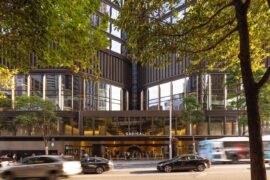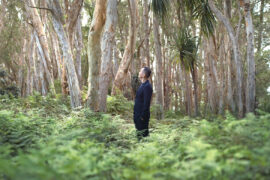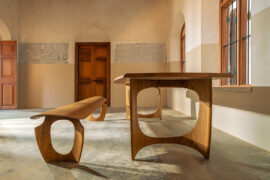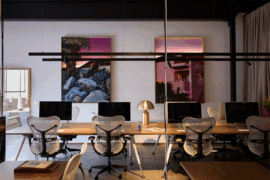Vert, an innovative demountable pergola designed for urban greening, is reshaping the way we think about sustainability in urban architecture.

December 9th, 2024
Record-breaking global temperatures were observed this year, with heatwaves becoming more intense and frequent. Even elite athletes at the 2024 Paris Olympics grappled with extreme heat as temperatures soared to 40°C. Experts warn that cities are heating at twice the rate of the global average, intensifying the effects of climate change.
The combined impact of climate change and biodiversity loss driven by rapid urbanisation poses a dual threat to human health and a profound existential crisis for the planet. This raises a critical question: how can cities adapt to become more climate-resilient while restoring and protecting biodiversity?
In response, German industrial designers Diez Office and urban-greening specialists OMC°C, in partnership with American Hardwood Export Council (AHEC), introduced Vert as an innovative solution. Unveiled at this year’s London Design Festival, Vert is a ten-metre-tall modular pergola that provides a green haven in cityscapes where conventional planting isn’t feasible. At its core, Vert embodies two key principles: promoting urban greenery and leveraging sustainable materials, particularly red oak glulam.

Vert’s 10x10x10m framework supports hemp netting where resilient, fast-growing plants thrive. These green facades provide shade, shelter, and habitats for insects and birds, making it a sanctuary for wildlife. For city dwellers, Vert offers a refreshing connection to nature, which is proven to enhance mental well-being.

By bringing greenery into areas unsuitable for rooted vegetation, Vert bridges the gap between concrete jungles and natural habitats. It demonstrates how thoughtful design can create spaces that support biodiversity and enhance urban life.
A defining feature of Vert is its construction material: red oak glulam (glued-laminated timber). Developed in collaboration with AHEC, this engineered timber combines sustainability with performance.

Red oak, a lesser-used yet abundant American hardwood species, accounts for 18% of the U.S. hardwood forest. By utilising red oak, Vert challenges industry norms and emphasises the need to diversify hardwood usage to promote forest resilience while reducing reliance on energy-intensive materials like concrete and steel.
Related: Material diversity with AHEC: Embrace the imperfect, underutilised and overlooked
Red oak glulam’s high density and strength-to-weight ratio enable slimmer structural elements compared to softwood alternatives, making it ideal for urban architecture. This efficiency not only reduces material usage but also narrows the cost gap between hardwood and softwood engineered timber.

Vert’s construction reflects cutting-edge engineering and collaboration. Neue Holzbau, pioneer in engineered wood, developed the red oak glulam using advanced bonding techniques. The result is a material with exceptional tensile strength and structural reliability, outperforming traditional hardwoods like European and American white oak in critical tests.

Bollinger + Grohmann’s engineering expertise ensured Vert’s stability, even under challenging wind loads. The structure is anchored to steel base plates for non-invasive installation, ensuring ease of relocation and reduced ecological impact which further extendsits lifespan.
Related: +Pavilion explores the future of sustainable construction
The timber connections employ Neue Holzbau’s proprietary GSA Technology, combining durability with precision. A Saicos water-based finish and UV coating protects the glulam, while the thermally modified red oak deck remains unfinished, showcasing the material’s natural beauty and resilience.

Vert is more than an innovative installation; it’s testament to the potential of engineered hardwood for sustainable urban development. Its success paves the way for using red oak glulam in office buildings, schools, sports facilities, and beyond.
As cities face increasing pressure to reduce their environmental footprint, projects like Vert demonstrate how sustainable materials, forward-thinking design and resourceful engineeringcan create greener, healthier urban spaces.
americanhardwood.org
We think you might also like Generative AI and its implications on design: Man x Machine x Material
INDESIGN is on instagram
Follow @indesignlive
A searchable and comprehensive guide for specifying leading products and their suppliers
Keep up to date with the latest and greatest from our industry BFF's!

For Aidan Mawhinney, the secret ingredient to Living Edge’s success “comes down to people, product and place.” As the brand celebrates a significant 25-year milestone, it’s that commitment to authentic, sustainable design – and the people behind it all – that continues to anchor its legacy.

Rising above the new Sydney Metro Gadigal Station on Pitt Street, Investa’s Parkline Place is redefining the office property aesthetic.

London-based design duo Raw Edges have joined forces with Established & Sons and Tongue & Groove to introduce Wall to Wall – a hand-stained, “living collection” that transforms parquet flooring into a canvas of colour, pattern, and possibility.

In Naturalizing Architecture, Takada moves beyond biomimicry to propose a regenerative vision for the urban environment.

Architect, designer and craftsman Adam Markowitz bridges the worlds of architecture and fine furniture, blending precision, generosity and advocacy to strengthen Australia’s craft and design community.
The internet never sleeps! Here's the stuff you might have missed

Architect, designer and craftsman Adam Markowitz bridges the worlds of architecture and fine furniture, blending precision, generosity and advocacy to strengthen Australia’s craft and design community.

With a minimalist aesthetic and an inventive approach to product, ZETR is challenging the way electrical accessories are designed, made and experienced.